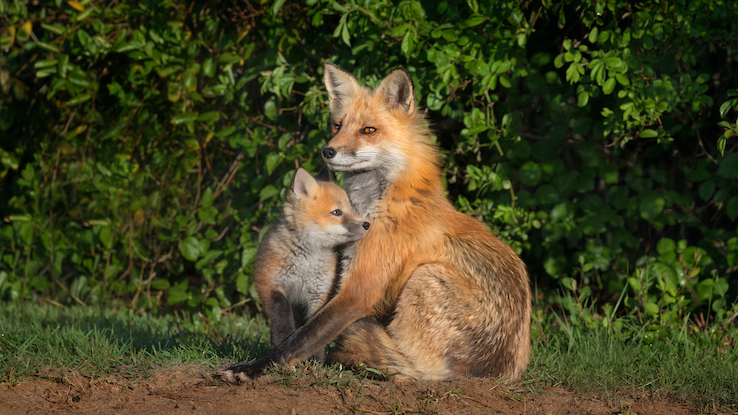What Is a Baby Fox Called?

As it turns out, there are a few answers to the question “What do you call a baby fox?” A baby fox is typically called a kit, cub or pup. Adult male foxes may be called dogs, tods or reynards, while adult female foxes are called vixens. A group of foxes may be called a skulk, leash or an earth. Foxes are highly social animals, and this plays a role in the babies’ upbringing.
Along with wolves, domestic dogs, jackals, dingoes, coyotes and other dog-like animals, foxes are classified scientifically as part of the canidae family. They’re some of the smallest creatures in the classification, and there are about 12 species of fox. The most common is the red fox, which can be found throughout North America, Europe, Australia, and Asia. The gray fox is also common and can be found throughout North America and Central America.
Species of Foxes
Reproduction
Most fox species are generally solitary animals, although they do form family bonds. Most of the time, one single female fox in each family will become pregnant during a mating season while the other less dominant females help her raise her pups. If the female dies, the male may take over until the pups are grown. Just before the babies are born, the fox family digs a den that is large enough for the entire family to live in. After they’re born, the family stays within close range of the den for about three months, only leaving to find food.
Fox Pups and Their Upbringing
For the first few months of life, the baby fox depends on its mother and her family to take care of it. However, both parents do play key roles in caring for the new babies. Most vixens give birth to about four or five pups at a time, although some species may have more. For the first few weeks, they are deaf, blind and totally dependent on their parents to help keep them safe from predators. They survive by drinking milk from their mother while their father goes out hunting for food. Once they can see and hear, fox pups begin playing with each other. Playtime eventually becomes aggressive as they practice hunting and fighting off predators. Some pups leave their families by age six months, while others stay around for life.
Behavior of a Fox
Even as fox pups mature into adults, they remain curious and playful animals. Like domestic dogs, they enjoy playing with toys like balls and have even been caught on video stealing balls from people’s yards. Some species, like the gray fox, climb trees. All species are mostly nocturnal, although they may come out during the daytime. Then they hunt, they pounce on their prey, much like a cat does.
Fox’s Diet
All species of foxes are omnivores, eating a wide range of both plants and smaller animals. They may hunt smaller mammals, like rabbits, squirrels, voles and mice, as well as birds, reptiles and amphibians. Foxes that live near farms may snatch chickens for meals, while foxes that live near the ocean may eat fish and small crustaceans. Otherwise, they may eat berries, fruits and vegetables. Foxes that live in populated areas may turn to garbage cans for scraps.
Baby Fox Sounds
The average fox can make about 40 different sounds. Some of them make sounds similar to a domestic dog. Some of them have been mistaken for babies or women screaming. Foxes also howl, cry and bark. Fox pups tend to make a more playful sound that’s similar to an “ack-ack-ack” or laughing, particularly when they’re engaging with other pups. If they feel threatened by a predator, they can bark similarly to a dog to alert their parents. However, these barks are higher in pitch and may sound like yips.
Foxes and Humans
Foxes generally stay away from humans, although history suggests that wasn’t always the case. When archaeologists opened a 16,500-year-old grave in Jordan in 2011, they found not only human remains, but that the person had been buried with his pet fox. During the 1800s, fox hunting became a popular sport for the upper class in the United Kingdom but, today, it remains a controversial topic for animal rights activists.





